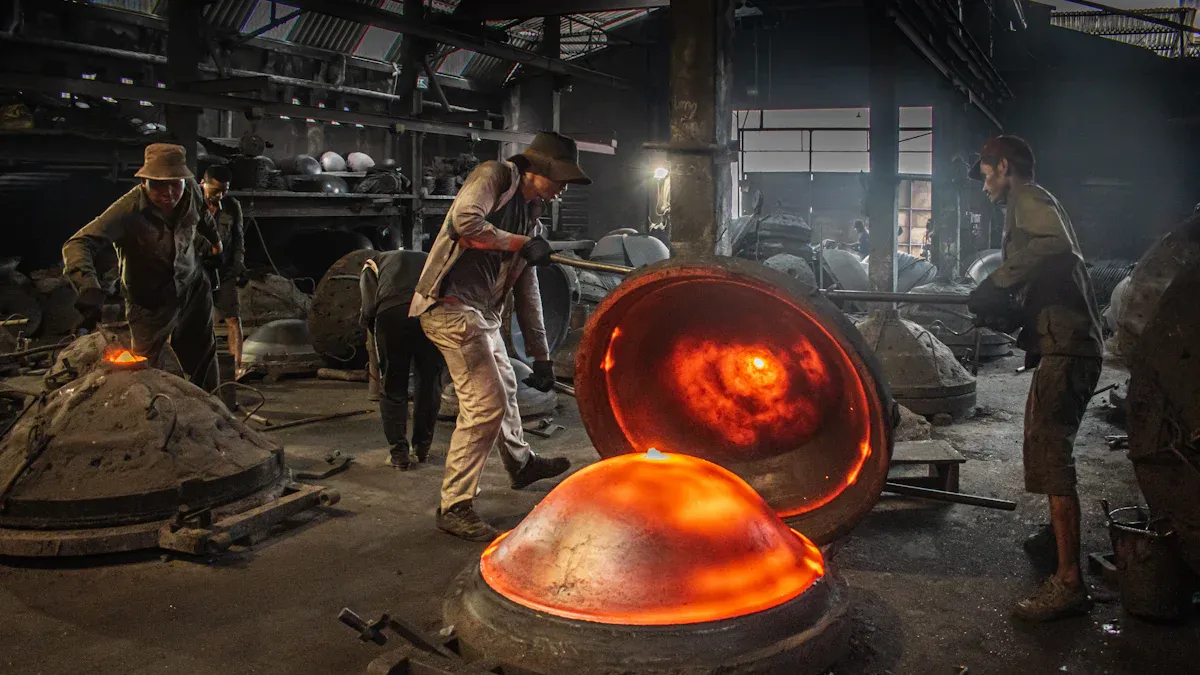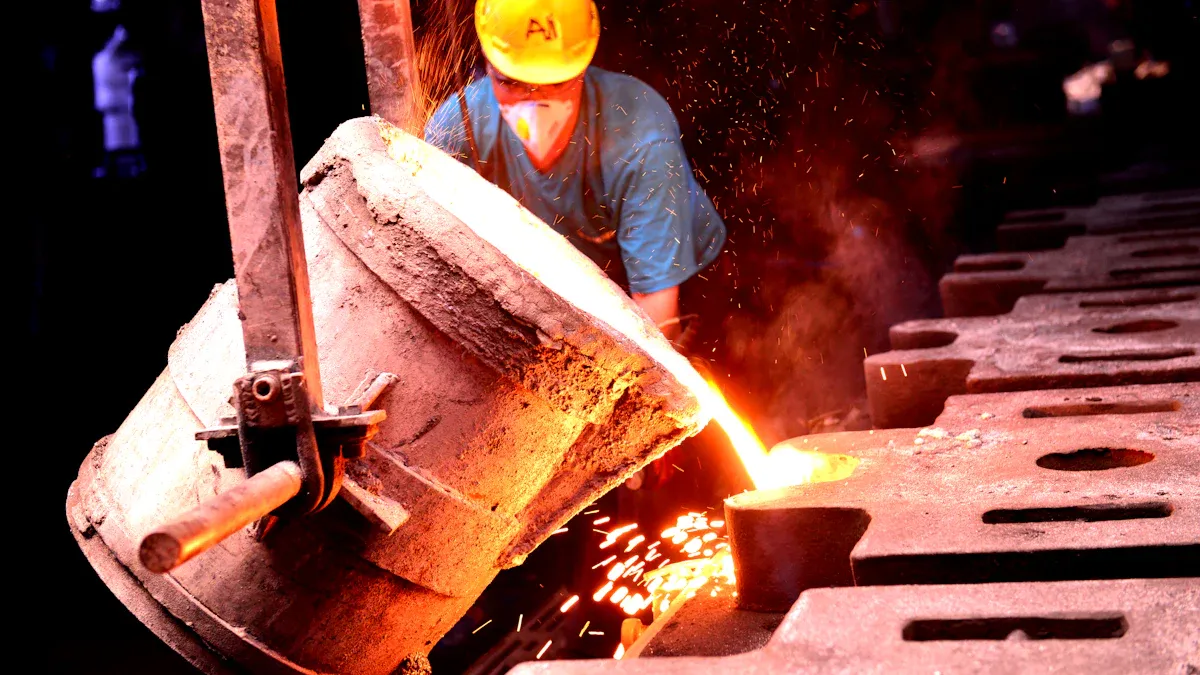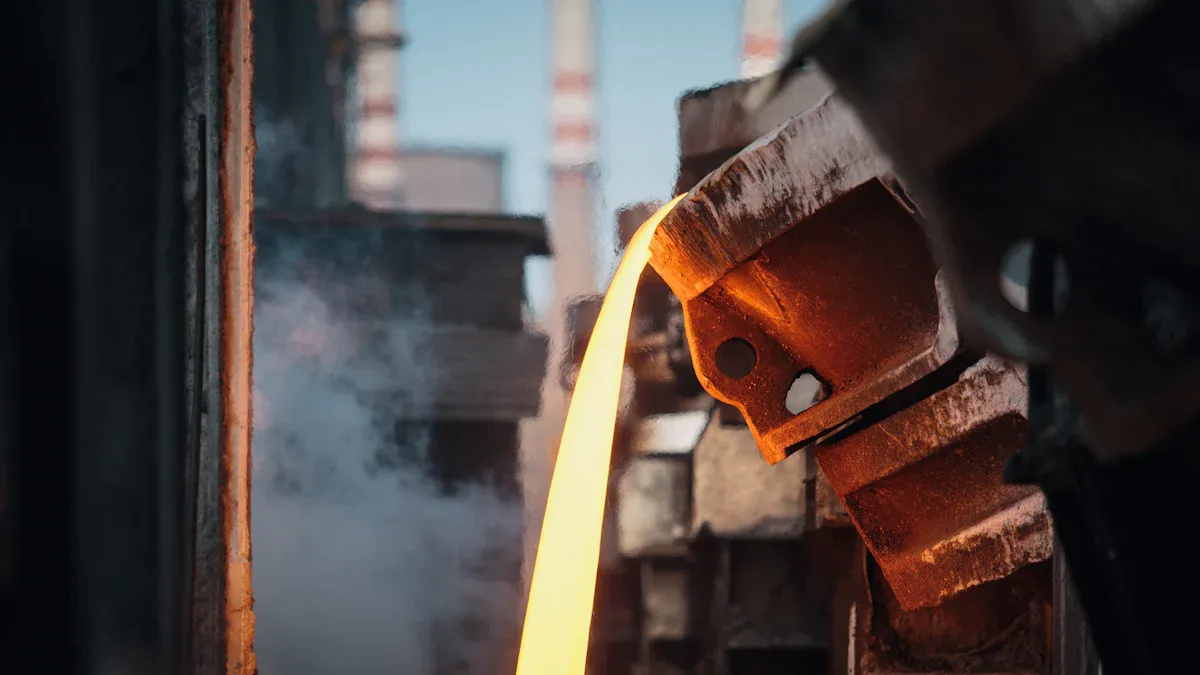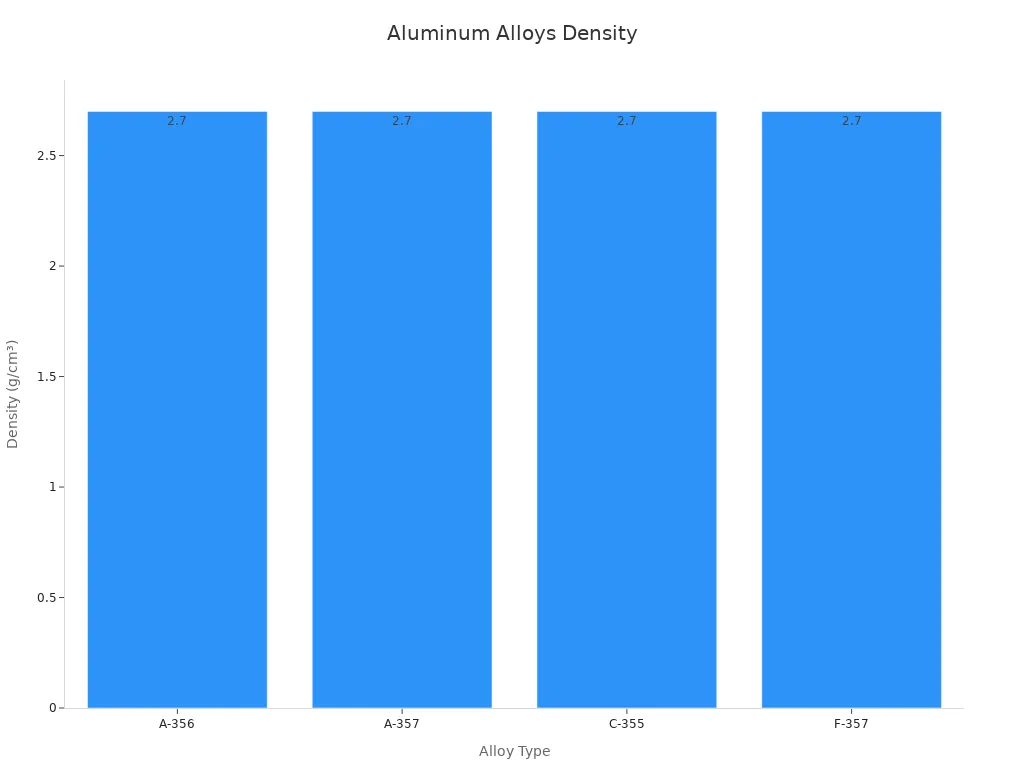
Investment Metal Alloy Casting plays a key role in creating high-performance components. The choice of alloy directly impacts quality and precision. For instance, the CHAMPS project shows how material property data for alloys like A206-T4 improves designs for flight-critical aircraft parts. Ningbo Pingheng Machinery Co.,Ltd, one of the best in Investment Metal Alloy Precision Casting, ensures optimal alloy selection for top-notch results in Investment Precision Casting Fabrication.
Key Takeaways
- Investment casting makes exact metal parts with smooth surfaces. This is very important for industries like airplanes and cars.
- Picking the right metal, like stainless steel to stop rust or aluminum because it is light, improves how things work and saves money.
- Talking to experts, like those at Ningbo Pingheng Machinery Co.,Ltd, helps choose the best metal for a project. This ensures great results in investment casting.
Stainless Steel in Investment Metal Alloy Casting

Properties of Stainless Steel
Stainless steel is a versatile material known for its exceptional properties. It resists rust and corrosion, making it ideal for environments exposed to moisture or chemicals. Its high strength ensures durability, even under heavy loads. Additionally, stainless steel maintains its mechanical properties over time, offering excellent long-term performance.
| Benefit | Description |
|---|---|
| Corrosion Resistance | Stainless steel is resistant to rust and corrosion, making it ideal for harsh environments. |
| High Strength | It offers superior strength compared to other materials, ensuring durability in applications. |
| Excellent Durability | Stainless steel maintains its properties over time, making it suitable for long-term use in various industries. |
These qualities make stainless steel a preferred choice for many industries, including construction, automotive, and aerospace.
Applications and Benefits of Stainless Steel
Stainless steel plays a crucial role in manufacturing components for heavy machinery. Gears, gear housings, and rotating shafts often rely on stainless steel due to its ability to withstand constant mechanical loads without deforming. Its high tensile strength and wear resistance make it indispensable for such applications.
Industries also benefit from stainless steel’s versatility. For example:
- Medical Industry: Stainless steel is used to create custom orthopedic implants like hip and knee replacements. These implants improve patient outcomes and reduce surgery times.
- Firearms Industry: Precision components such as triggers and receivers are crafted using stainless steel. This enhances reliability while lowering production costs.
To ensure quality, manufacturers conduct rigorous testing. They verify tensile strength, corrosion resistance, and chemical composition. Non-destructive techniques like X-ray inspections help identify internal flaws, ensuring the final product meets industry standards.
Stainless steel’s unique properties and wide-ranging applications make it a cornerstone of Investment Metal Alloy Casting, delivering unmatched performance and reliability.
Carbon Steel Alloys for Investment Casting
Properties of Carbon Steel
Carbon steel is a widely used material in investment casting due to its excellent mechanical properties. It offers high strength, toughness, and wear resistance, making it suitable for demanding applications. The carbon content in the alloy determines its hardness and ductility, allowing manufacturers to tailor it for specific needs.
To ensure quality, various tests verify the characteristics of carbon steel used in investment casting. These tests assess its strength, durability, and surface integrity. Here’s a quick look at the common tests:
| Test Type | Purpose | Measured Properties |
|---|---|---|
| Tensile Testing | Strength Assessment | Ultimate strength, yield strength, elongation |
| Impact Testing | Toughness Evaluation | Impact resistance, ductility |
| Hardness Testing | Surface Resistance | Brinell, Rockwell, Vickers hardness |
| Radiographic Testing | Internal defects, porosity | Critical components |
| Magnetic Particle | Surface cracks, seams | Ferromagnetic parts |
| Ultrasonic Testing | Internal flaws, inclusions | Thick sections |
| Dye Penetrant | Surface discontinuities | All casting surfaces |
These tests ensure that carbon steel meets the rigorous demands of industries relying on investment casting.
Applications and Benefits of Carbon Steel
Carbon steel is a go-to material for manufacturing components that require strength and durability. Industries like automotive, construction, and agriculture rely on it for parts such as gears, brackets, and structural supports. Its ability to withstand heavy loads and resist wear makes it ideal for these applications.
One of the standout benefits of carbon steel is its cost-effectiveness. It provides excellent performance at a lower cost compared to other alloys. This makes it a popular choice for large-scale production. Additionally, carbon steel’s versatility allows manufacturers to create complex shapes with precision, a key advantage in investment metal alloy casting.
In the construction industry, carbon steel is used for beams and reinforcements due to its high tensile strength. In agriculture, it forms the backbone of machinery parts like plowshares and harrows. Its adaptability and reliability make it indispensable across various sectors.
Carbon steel’s combination of strength, affordability, and versatility ensures its continued importance in investment casting processes.
Aluminum Alloys in Investment Casting

Properties of Aluminum Alloys
Aluminum alloys are lightweight yet strong, making them a popular choice in investment casting. Their low density (~2.7 g/cm³) ensures reduced weight without compromising durability. These alloys also exhibit excellent corrosion resistance, making them suitable for harsh environments. Weldability is another key feature, allowing seamless integration into complex designs.
| Alloy Type | Density (g/cm³) | Applications | Properties |
|---|---|---|---|
| A-356 | ~2.7 | Aircraft parts | Corrosion resistance, weldability, strength |
| A-357 | ~2.7 | Engine components | Corrosion resistance, weldability, strength |
| C-355 | ~2.7 | Industrial parts | Corrosion resistance, weldability, strength |
| F-357 | ~2.7 | Aerospace components | Corrosion resistance, weldability, strength |
Grain refinement techniques, such as twin-roll casting, further enhance the microhardness of aluminum alloys. This improvement boosts wear resistance and tensile strength, making them ideal for demanding applications. However, achieving a balance between hardness and machinability is crucial for optimal performance.

Applications and Benefits of Aluminum Alloys
Aluminum alloys shine in industries like automotive, aerospace, and electronics. Their lightweight nature reduces the overall weight of components, improving fuel efficiency and performance. For instance, automotive transmission housings made from aluminum alloys enhance thermal performance and structural durability.
In electronics, aluminum alloys are used for heat sinks. These components effectively manage heat, ensuring longer lifespans for devices. In aerospace, avionics housings crafted from aluminum alloys protect sensitive electronics from extreme conditions, ensuring reliability.
| Application | Benefits |
|---|---|
| Automotive Transmission Housing | Lighter components improve fuel efficiency, thermal performance, and structural durability. |
| Electronics Heat Sinks | Effectively manage heat, enhancing processing capabilities and component longevity. |
| Aircraft Avionics Housing | Protects electronics against extreme conditions, ensuring reliability and durability. |
The versatility of aluminum alloys in investment metal alloy casting allows manufacturers to create intricate designs with precision. This adaptability, combined with their strength and corrosion resistance, makes aluminum alloys a cornerstone material in modern manufacturing.
Nickel-Based Alloys in Investment Casting
Properties of Nickel-Based Alloys
Nickel-based alloys are known for their exceptional strength and durability. These materials can withstand high stress, making them perfect for demanding applications. Their thermal stability allows them to retain strength even at extreme temperatures, which is essential for components like jet engine parts and heat exchangers. Additionally, nickel alloys resist fatigue, enabling them to endure repeated stress cycles without failure.
Some popular nickel-based alloys, such as Inconel and Monel, stand out for their high-temperature and corrosion resistance. This makes them ideal for industries like aerospace and energy. The addition of elements like chromium and molybdenum enhances their ability to resist corrosion and maintain stability in harsh environments. For example, Inconel 718 and Inconel 625 are widely used in gas turbines due to their high-temperature strength and creep resistance. These alloys can maintain structural integrity at temperatures up to 980°C, making them indispensable in power generation applications.
Applications and Benefits of Nickel-Based Alloys
Nickel-based alloys play a vital role in various industries. In aerospace, they are used to manufacture turbine blades and jet engine components. Their ability to handle extreme heat and stress ensures reliable performance in critical applications. In the energy sector, these alloys are used in heat exchangers and power generation equipment, where their thermal stability and corrosion resistance shine.
Medical devices and consumer electronics also benefit from nickel alloys. Their mechanical strength and dimensional stability make them ideal for precision parts. For instance, Hastelloy C-276 is often chosen for environments with inorganic acids due to its excellent chemical corrosion resistance. This versatility makes nickel-based alloys a cornerstone of Investment Metal Alloy Casting, offering unmatched performance and reliability across industries.
Cobalt-Based Alloys for Investment Casting
Properties of Cobalt-Based Alloys
Cobalt-based alloys are renowned for their exceptional performance in challenging environments. These materials exhibit high strength and toughness, making them ideal for extreme conditions. Their ability to resist high temperatures ensures reliability in applications like aerospace and power generation. Additionally, they offer superior corrosion and wear resistance, which enhances their longevity in demanding settings.
- High Strength and Toughness: Perfect for extreme environments.
- Temperature Resistance: Essential for aerospace and power generation applications.
- Corrosion and Wear Resistance: Ensures durability in harsh conditions.
- High-Temperature Creep Strength: Maintains structural integrity under stress.
- Resistance to Hot Corrosion: Ideal for gas turbines and aerospace components.
Technical studies have further highlighted the mechanical properties of cobalt chromium alloys. Tests like microhardness, wear resistance, and flexural bending provide valuable insights into their performance. These properties make cobalt-based alloys a reliable choice for investment casting solutions.
Applications and Benefits of Cobalt-Based Alloys
Cobalt-based alloys play a vital role in industries that demand high performance. In aerospace, they are used to manufacture gas turbines and jet engine components. Their ability to withstand extreme heat and stress ensures safety and efficiency. Power generation facilities also rely on these alloys for components like heat exchangers, where temperature resistance is critical.
Medical applications benefit from cobalt-based alloys as well. Their biocompatibility and wear resistance make them suitable for orthopedic implants like hip and knee replacements. These alloys also find use in industrial machinery, where their toughness and corrosion resistance extend the lifespan of critical parts.
By leveraging the unique properties of cobalt-based alloys, manufacturers can produce components that excel in durability, reliability, and performance. This makes them an indispensable material in Investment Metal Alloy Casting.
Copper-Based Alloys in Investment Casting
Properties of Copper-Based Alloys
Copper-based alloys are prized for their excellent thermal and electrical conductivity. These materials also offer impressive corrosion resistance, making them ideal for harsh environments. Their natural antimicrobial properties add another layer of versatility, especially in medical and food-related applications.
The mechanical properties of copper alloys make them suitable for precision casting. For instance, their density is approximately 8.71 g/cm³, and they exhibit a tensile strength of 221 MPa in as-cast conditions. These alloys also maintain good machinability, with a rating of 20, allowing manufacturers to create intricate designs with ease.
| Property | Metric | Imperial |
|---|---|---|
| Density | 8.71 g/cm³ | 0.315 lb/in³ |
| Hardness (Brinell) | 105 | 105 |
| Tensile Strength (as cast) | 221 MPa | 32100 psi |
| Yield Strength (as cast) | 172 MPa | 24900 psi |
| Elongation at Break | 2% | 2% |
| Machinability | 20 | 20 |
| Elastic Modulus | 117 GPa | 17000 ksi |
Research also highlights the role of modifying agents like ODM2 and Kupmod2 in enhancing specific properties. These agents improve wear resistance and optimize heat treatment parameters, ensuring the alloy performs well in demanding applications.
Applications and Benefits of Copper-Based Alloys
Copper-based alloys find use across a wide range of industries. Their high electrical conductivity makes them indispensable in electrical components like connectors and busbars. In plumbing, these alloys are used for pipes and fittings due to their corrosion resistance and durability.
In marine environments, copper alloys excel in resisting seawater corrosion. This makes them a preferred choice for ship propellers and underwater fittings. Additionally, their antimicrobial properties make them ideal for medical devices and food processing equipment, where hygiene is critical.
| Aspect | Details |
|---|---|
| Quality Assessment | Based on microstructure, chemical content analysis, and strength properties tests. |
| Deoxidizing Agents | Use of Logas and Cup formulas for enhancing electrical conductivity. |
| Modifying Agents | ODM2 and Kupmod2 used for improving properties in specific applications. |
| Alloy Composition | Studies on copper alloys with varied Cr and Zr content to optimize heat treatment parameters. |
| Wear Resistance Research | Investigated the influence of silicone content on CuNiSi alloy properties. |
Copper-based alloys also contribute to sustainable manufacturing. Their recyclability reduces waste and supports eco-friendly practices. This combination of performance, versatility, and sustainability makes copper alloys a cornerstone of investment metal alloy casting.
Investment Metal Alloy Casting provides unmatched versatility by leveraging the unique properties of various alloys. Each alloy offers distinct advantages, from the high strength of steel to the lightweight nature of aluminum. Selecting the right alloy ensures optimal performance and cost-effectiveness across industries.
| Alloy Type | Key Benefits | Market Growth | Applications |
|---|---|---|---|
| Steel | High strength, durability, versatility | Largest revenue share | Aerospace, automotive, industrial |
| Aluminum | Lightweight, corrosion resistance | Fastest CAGR growth | Automotive, aerospace |
Ningbo Pingheng Machinery Co.,Ltd excels in helping clients achieve high-quality results through expert alloy selection and precision casting solutions.
FAQ
What is investment casting, and why is it important?
Investment casting creates precise metal parts using molds. It ensures high accuracy, smooth finishes, and complex designs, making it essential for industries like aerospace and automotive.
How do I choose the right alloy for my project?
Consider the application’s requirements, such as strength, corrosion resistance, and weight. Ningbo Pingheng Machinery Co.,Ltd offers expert guidance to help you select the best alloy.
Tip: Always consult professionals to match alloy properties with your project needs.
Can investment casting reduce production costs?
Yes! Investment casting minimizes material waste and reduces machining needs. It’s cost-effective for producing intricate designs and large quantities with consistent quality.
